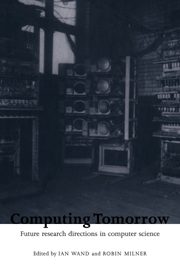Book contents
- Frontmatter
- Contents
- Preface
- Contributors
- 1 The Complexity of Algorithms
- 2 Building Novel Software: the Researcher and the Marketplace
- 3 Prospects for Artificial Intelligence
- 4 Structured Parallel Programming: Theory meets Practice
- 5 Computer Science and Mathematics
- 6 Paradigm Merger in Natural Language Processing
- 7 Large Databases and Knowledge Re-use
- 8 The Global-yet-Personal Information System
- 9 Algebra and Models
- 10 Real-time Computing
- 11 Evaluation of Software Dependability
- 12 Engineering Safety-Critical Systems
- 13 Semantic Ideas in Computing
- 14 Computers and Communications
- 15 Interactive Computing in Tomorrow's Computer Science
- 16 On the Importance of Being the Right Size
- References
- Index
14 - Computers and Communications
Published online by Cambridge University Press: 10 December 2009
- Frontmatter
- Contents
- Preface
- Contributors
- 1 The Complexity of Algorithms
- 2 Building Novel Software: the Researcher and the Marketplace
- 3 Prospects for Artificial Intelligence
- 4 Structured Parallel Programming: Theory meets Practice
- 5 Computer Science and Mathematics
- 6 Paradigm Merger in Natural Language Processing
- 7 Large Databases and Knowledge Re-use
- 8 The Global-yet-Personal Information System
- 9 Algebra and Models
- 10 Real-time Computing
- 11 Evaluation of Software Dependability
- 12 Engineering Safety-Critical Systems
- 13 Semantic Ideas in Computing
- 14 Computers and Communications
- 15 Interactive Computing in Tomorrow's Computer Science
- 16 On the Importance of Being the Right Size
- References
- Index
Summary
Progress in the computer and communication industries has run in parallel for a great many years, and convergence or even unity has often been predicted. Do they not, after all, both use digital circuits and the associated logic? The present chapter seeks to investigate why the convergence has not happened, and to look into the future.
The earliest contacts, at any rate in the civil sphere, were in some sense casual. Data transmission, as the subject was known, was not in any way regarded as an integral part of computing but rather as an added facility that one was well advised to have some understanding of – rather like air-conditioning.
Early Contacts
What started to bring the two activities into more serious contact was the development of time-sharing systems. As soon as it was demonstrated that these systems were very valuable means to improve the human convenience of using computers it was obviously necessary to connect terminals in considerable numbers. At first these tended to be in the same buildings as the computers they served, and the physical connections were wholly under the control of the computer people. There was not much, if any, suitable equipment one could go and buy; accordingly computer engineers learned about transmission, designed multiplexors, and so on. They found it not unfamiliar, and not too difficult. Before long, however, it became necessary to communicate off site, or off campus. This revealed that in most if not all countries there were legal restrictions on who could provide telecommunication facilities outside a single site. The rules varied. Maybe it was a matter of crossing a highway, or of going to land in different ownership.
- Type
- Chapter
- Information
- Computing TomorrowFuture Research Directions in Computer Science, pp. 284 - 294Publisher: Cambridge University PressPrint publication year: 1996



